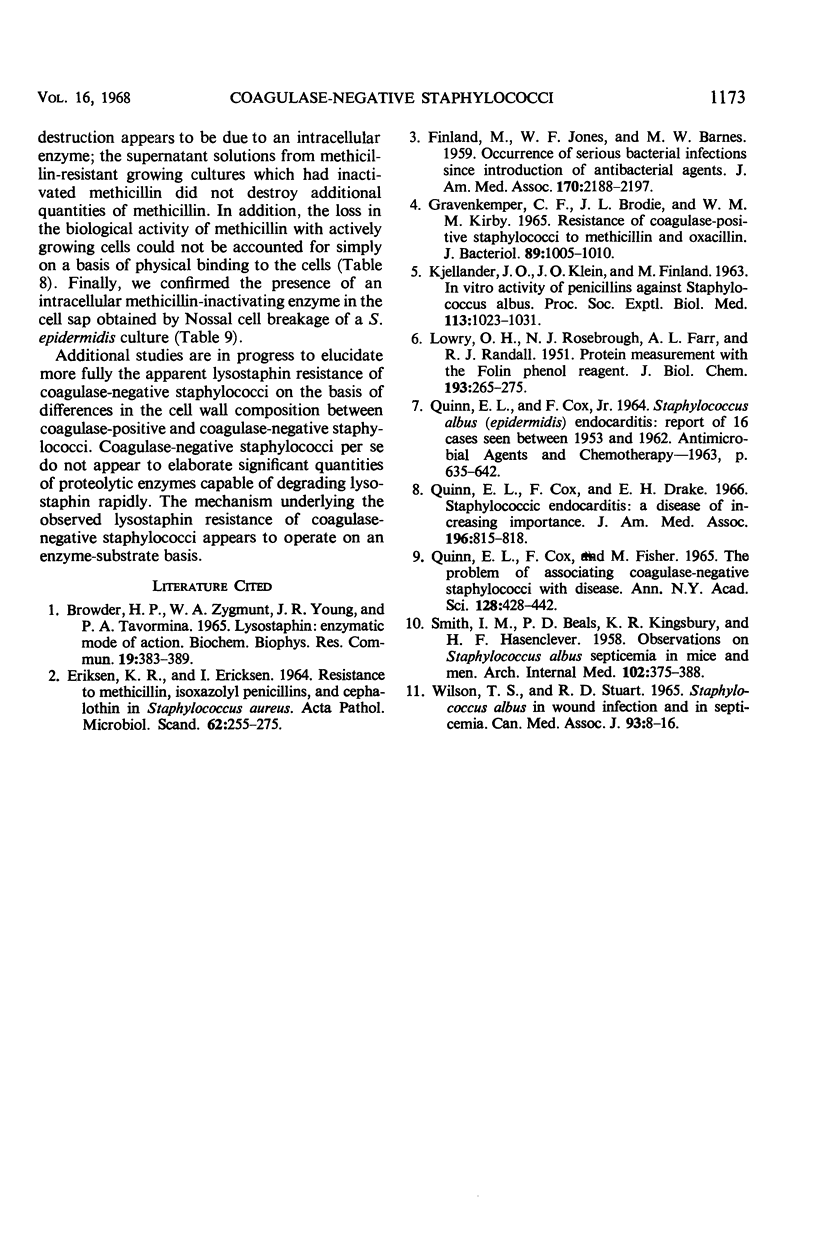Abstract
In general, coagulase-negative staphylococci were found to be relatively less susceptible to the lytic action of lysostaphin than coagulase-positive staphylococci. To achieve, arbitrarily, a lysis greater than 75%, it was necessary to use an increased concentration of enzyme or a longer incubation period than that usually required with coagulase-positive strains. For the most part, the cultures studied were sensitive to oxacillin, cloxacillin, dicloxacillin, nafcillin, ancillin, cephalothin, cephaloridine, fusidic acid, lincomycin, novobiocin, and neomycin [median minimal inhibitory concentrations (MIC) of 1.56 μg/ml or less]. Some degree of resistance (median MIC values of 12.5 μg/ml or greater) to benzylpenicillin, ampicillin, methicillin, tetracycline, chloretetracycline, erythromycin, ristocetin, and lysostaphin was found. Ten methicillin-resistant, coagulase-negative staphylococal strains were found to be cross-resistant to all nine of the penicillins tested, but much less resistant to the two cephalosporin analogues. In several instances, some of these strains seemed to be more sensitive to benzylpenicillin and to certain of the semisynthetic penicillins than to methicillin. Of the 18 antibiotics tested with the viable plate count method, the methicillin-resistant strains were found to be the most sensitive to lincomycin and novobiocin.
Full text
PDF





Selected References
These references are in PubMed. This may not be the complete list of references from this article.
- BROWDER H. P., ZYGMUNT W. A., YOUNG J. R., TAVORMINA P. A. LYSOSTAPHIN: ENZYMATIC MODE OF ACTION. Biochem Biophys Res Commun. 1965 Apr 23;19:383–389. doi: 10.1016/0006-291x(65)90473-0. [DOI] [PubMed] [Google Scholar]
- ERIKSEN K. R., ERICHSEN I. RESISTANCE TO METHICILLIN, ISOXAZOLYL PENICILLINS, AND CEPHALOTHIN IN STAPHYLOCOCCUS AUREUS. Acta Pathol Microbiol Scand. 1964;62:255–275. doi: 10.1111/apm.1964.62.2.255. [DOI] [PubMed] [Google Scholar]
- FINLAND M., JONES W. F., Jr, BARNES M. W. Occurrence of serious bacterial infections since introduction of antibacterial agents. J Am Med Assoc. 1959 Aug 29;170:2188–2197. doi: 10.1001/jama.1959.63010180008012. [DOI] [PubMed] [Google Scholar]
- GRAVENKEMPER C. F., BRODIE J. L., KIRBY W. M. RESISTANCE OF COAGULASE-POSITIVE STAPHYLOCOCCI TO METHICILLIN AND OXACILLIN. J Bacteriol. 1965 Apr;89:1005–1010. doi: 10.1128/jb.89.4.1005-1010.1965. [DOI] [PMC free article] [PubMed] [Google Scholar]
- KJELLANDER J. O., KLEIN J. O., FINLAND M. IN VITRO ACTIVITY OF PENICILLINS AGAINST STAPHYLOCOCCUS ALBUS. Proc Soc Exp Biol Med. 1963 Aug-Sep;113:1023–1031. doi: 10.3181/00379727-113-28563. [DOI] [PubMed] [Google Scholar]
- LOWRY O. H., ROSEBROUGH N. J., FARR A. L., RANDALL R. J. Protein measurement with the Folin phenol reagent. J Biol Chem. 1951 Nov;193(1):265–275. [PubMed] [Google Scholar]
- Quinn E. L., Cox F., Drake E. H. Staphylococcic endocarditis. JAMA. 1966 Jun 6;196(10):815–818. [PubMed] [Google Scholar]
- Quinn E. L., Cox F., Fisher M. The problem of associating coagulase-negative staphylococci with disease. Ann N Y Acad Sci. 1965 Jul 23;128(1):428–442. doi: 10.1111/j.1749-6632.1965.tb11652.x. [DOI] [PubMed] [Google Scholar]
- SMITH I. M., BEALS P. D., KINGSBURY K. R., HASENCLEVER H. F. Observations on Staphylococcus albus septicemia in mice and men. AMA Arch Intern Med. 1958 Sep;102(3):375–388. doi: 10.1001/archinte.1958.00030010375005. [DOI] [PubMed] [Google Scholar]
- WILSON T. S., STUART R. D. STAPHYLOCOCCUS ALBUS IN WOUND INFECTION AND IN SEPTICEMIA. Can Med Assoc J. 1965 Jul 3;93:8–16. [PMC free article] [PubMed] [Google Scholar]


